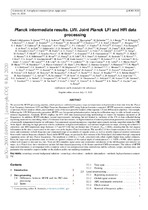Planck intermediate results. LVII. Joint Planck LFI and HFI data processing
Abstract
We present the NPIPE processing pipeline, which produces calibrated frequency maps in temperature and polarization from data from the Planck
Low Frequency Instrument (LFI) and High Frequency Instrument (HFI) using high-performance computers. NPIPE represents a natural evolution
of previous Planck analysis efforts, and combines some of the most powerful features of the separate LFI and HFI analysis pipelines. For example,
following the LFI 2018 processing procedure, NPIPE uses foreground polarization priors during the calibration stage in order to break scanninginduced degeneracies. Similarly, NPIPE employs the HFI 2018 time-domain processing methodology to correct for bandpass mismatch at all
frequencies. In addition, NPIPE introduces several improvements, including, but not limited to: inclusion of the 8 % of data collected during
repointing manoeuvres; smoothing of the LFI reference load data streams; in-flight estimation of detector polarization parameters; and construction
of maximally independent detector-set split maps. For component-separation purposes, important improvements include: maps that retain the CMB
Solar dipole, allowing for high-precision relative calibration in higher-level analyses; well-defined single-detector maps, allowing for robust CO
extraction; and HFI temperature maps between 217 and 857 GHz that are binned into 0.09 pixels (Nside = 4096), ensuring that the full angular
information in the data is represented in the maps even at the highest Planck resolutions. The net effect of these improvements is lower levels of
noise and systematics in both frequency and component maps at essentially all angular scales, as well as notably improved internal consistency
between the various frequency channels. Based on the NPIPE maps, we present the first estimate of the Solar dipole determined through component
separation across all nine Planck frequencies. The amplitude is (3366.6 ± 2.7) µK, consistent with, albeit slightly higher than, earlier estimates.
From the large-scale polarization data, we derive an updated estimate of the optical depth of reionization of τ = 0.051 ± 0.006, which appears
robust with respect to data and sky cuts. There are 600 complete signal, noise and systematics simulations of the full-frequency and detector-set
maps. As a Planck first, these simulations include full time-domain processing of the beam-convolved CMB anisotropies. The release of NPIPE
maps and simulations is accompanied with a complete suite of raw and processed time-ordered data and the software, scripts, auxiliary data, and
parameter files needed to improve further on the analysis and to run matching simulations.

